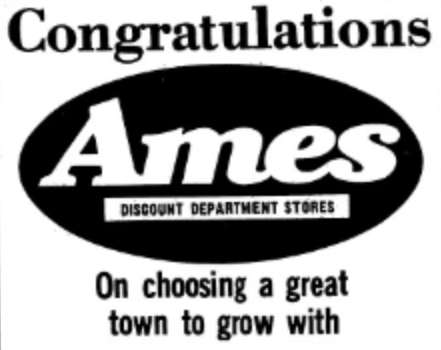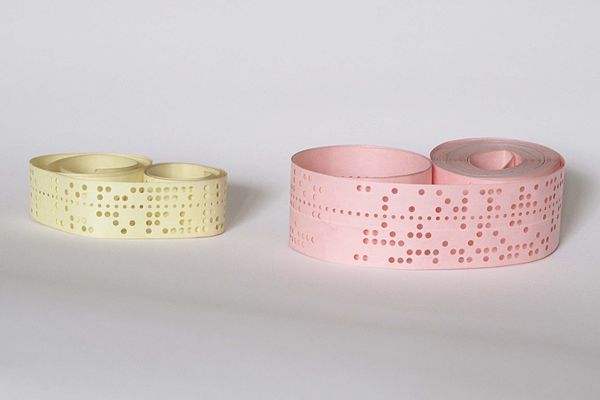My overall interest in computing equipment kicked into high gear when the Ames Discount Department Store chain opened in my hometown. It was September 1978 when the store opened, and I remember shopping there on opening day. To handle the crowds, several temporary checkout lanes had been installed near the exit of the store. These supplemented the four regular checkout lanes and the service desk.

At the time Ames was still using mechanical cash registers with inventory tracking capabilities. When the store opened it looked like some of the cash registers were not new. Some were darker in color than the others. After a few visits and my typical study of receipts, I found differences there too. While many of the receipts had a header and footer that THANK YOU and CALL AGAIN (very generic), some of the older registers printed an old Ames logo that looked like kids building blocks.
The cash registers were made by Sweda and resembled this register I had a couple of years ago.

There were a couple of differences from the register shown in the photo. First of all, Ames utilized a three digit class system for their inventory, so the fourth row of inventory numbers on the right side (positions 1000, 2000, and 3000) did not exist on the Ames registers. Instead, there was a second “Mdse Number” button where the 3000 button is shown above.
If you look on the left hand side of the register, you’ll see a small plastic window. The mechanism on that side of the register punched a data tape. Here’s a sample in a photo from Wikipedia. These registers used the narrower version of the tape shown on the left.

As cashiers rang up items they would enter the three digit class number on the left side of the keyboard and the amount of the item on the monetary keys. Other department stores did the same thing with Sweda registers, but the stores we frequented that also used this type of cash register usually had two-digit department numbers instead of the three numbers used by Ames.
In some instances, usually with clothing purchases, Ames tracked that inventory with “double pass” items. This is when the two modifier keys were used. For example, a garment might be marked 112 237 and the price. The cashier would press the top modifier key and punch in 112 with no monetary amount and hit the motor bar. The cashier would then press the bottom modifier key and punch in 237 and the price of the item.
I believe the use of the modifier buttons punched a special flag on the punch tape, perhaps indicating the “beginning” and “end” of the data for an item sold. I don’t believe the sale amount was recorded on the tape; a cursory inspection of the cash register I had seemed to indicate only inventory information was punched into the tape. On the rare instance that I was able to get my cash register to ring something up it would only punch four characters on the tape when ringing up an item.
The data tapes would be removed on a periodic basis and sent to a processing center. The spools of tape in the register were very long.
The cash registers were incapable of subtraction, so if an item was rung up wrong, the cashier would total out the sale and start over, saving the first receipt to be voided. This where the red VOID key was used. They’d ring the sale up all over again under the VOID key instead of the A key. It was then up to the managing team to take VOID totals and do the necessary math in the back office to balance the cashier’s drawer. I’m sure the data tape was also punched to indicate it was a void, which would put that inventory back into circulation.
Years ago I read a newspaper article about the Zellers chain in Canada; they had “triple pass” items where three codes were entered for an item.
Each of the registers at Ames were numbered with a unique number that appeared on the receipt. I remember Register 1 would print “984” up the right hand margin of the receipt. One of the older registers printed “017”. After a few visits I was able to determine which register belonged to what checkout lane. On the rare occasion a cash register was swapped out (due to mechanical issues or whatever), I’d have to figure out which checkout lane the register belonged to.
Ames held onto these mechanical Sweda registers into the 1980s. When Ames bought the Big N chain a year or two after the store opened in our town, we visited a former Big N that had been turned into an Ames. They did not have Sweda registers but instead ran with the venerable NCR Class 5 machines. The Class 5 registers also punched a tape and all of the same class number practices were in place. The only difference was the NCR Class 5 registers printed a “TX” (for tax) indicator on the receipt; the Sweda registers just showed tax as another item. Class 900 was used on both types of machines.
When Ames made the leap to electronic cash registers they moved to the IBM 3680 system with IBM 3683 and 3684 cash registers. I’ll be writing about that in a future blog entry.
Incidentally, the Sweda cash registers at a nearby Jamesway department store were inherited from the regional chain they purchased, which was called Westons. I remember going to Jamesway after the change over and seeing they were using the same registers. Something had been modified to prevent the “Westons” named being printed on the receipt but otherwise they worked identically to the way Westons had originally ran the inventory.
Computerized inventory with mechanical cash registers. I find the approach to be quite ingenious considering the equipment available at the time.
